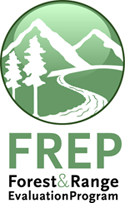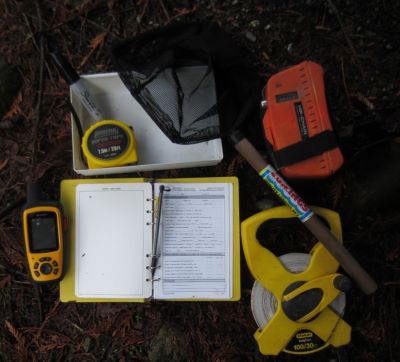Lesson 2- Training & Field Preparedness

Learning Objectives
The objective of this lesson is to prepare participants for successful training and field work.

Training Format & Agenda
The WMREE training is intended for anyone wishing to conduct wetland assessments for the first time, or for people who have had the training more than two years ago and have not undertaken any assessments since that time.
Unless otherwise indicated, the 1st day of training will start at the District office at 8:30am with an introductory PowerPoint presentation. This will be followed by a field skills session, preferably from the District’s FREP plan, at a block selected by the hosting District.
Candidates wanting to conduct WMREE assessments should recognize that the classroom/field training are covering the basics. In the field, each wetland and treatment will be slightly different than what was covered. Therefore, working with an experienced assessor when possible is advised for the newcomer. Experience shows that a person begins to perform confidently and proficiently once they have participated in the completion of 7-10 WMREE assessments AFTER attending the training.
Preparing for Training
It is mandatory that anyone signing up for WMREE training takes the time to pre-read the protocol and review the field cards. A technical guidance document has also been created to help with the data entry. These are all available on-line as PDF documents and it is a good idea to print or load them onto an ipad to carry with you as a reference. The field cards are also available as a FileMaker form, which makes calculations easier. If you plan to bring an iPad to training, be sure to load FileMaker GO and the newest version of the WMREE form onto your iPad. Extra field cards will be provided at the training, but you should also bring your own blank waterproof note paper in your 6-ring field book for note-taking purposes.
Equipment & Supplies
Equipment you will require to conduct WMREE field work (and training):
District FREP Kit: During training you will be introduced to the field skills required for the evaluation. There is a variety of field equipment that will be useful to bring to training along with your protocol and field cards. Each District should have a FREP ‘kit’ with the basic tools required for any and all resource assessments.

Personal Field Gear: The most useful equipment EACH member of an evaluation team should bring to training is a 6-ring field notebook (with blank waterproof note paper), pencil, permanent felt mark, roll of flagging tape, a 3m carpenter tape, a pocket calculator, compass, and a camera. Each district team should also have a 50 m rotary tape or hip chain, GPS, plant identification field resource books (including invasive plants) and soil auger OR small shovel.
Optional, but useful equipment includes a digital rangefinder, pH/temperature meter, ipad with the FileMaker wetland form downloaded on it and Land Management Handbook 52: “Wetlands of BC: a guide to classification” (available as pdf download free online),
Bag lunch & refreshments: In addition to the above equipment, each person will need to bring a bagged lunch, refreshments, and snacks.
Layered Clothing, Footwear & Miscellaneous: Persons must dress appropriately for the field work. Layered clothing is essential, as dictated by the weather, but should include a long-sleeved shirt/jacket and full-legged pants. Footwear must include tall rubber boots as a minimum because you will be in the wetland to take various measurements. At least one team member should bring a pair of hip-waders and/or chest waders. Also remember to bring insect repellent (season dependent), hi-vis field vest and hard hat.
Clean Your Gear: Please bring clean gear (i.e. waders/boots etc.). This helps reduce the spread of disease to amphibians; and helps reduce the spread of invasive plants/animals. If your equipment has recently been used elsewhere, a simple way to clean it before going somewhere new it is to soak it in a 5% bleach solution for 15 minutes and then air dry.
Preparing for Field Work
Once you have decided to book a field day to conduct WMREE assessments there are a few steps to take in preparation to making this day successful.

Reserve a vehicle from your fleet, preferably with 4x4 capability. On the field day, you will need to conduct a pre-trip vehicle inspection; this is going to take you several minutes, so plan to arrive a bit earlier than the agreed departure time. Be sure to check the vehicle for a spare tire, jack and lug wrench, radio with required channels and first aid kit.
Confirm the departure time with your team the day prior to departure. Enquire of colleagues at the office about road conditions and gates (you may need to sign out a key). Confirm the travel route and ensure you have the map for the field site, and perhaps bring the map for an alternate site in case the selected field site is not going to work.
Perform the safety sign-out and confirm the check-in protocol for your office. Conduct a radio check before leaving the office. If convoying with other vehicles, select a chat channel (e.g., LADD1) and establish a pre-determined pit stop location in case of vehicle separation. Confirm the end-of-day timing constraints, if any, before departing and plan your day accordingly.
Confirm the contents of the District FREP kit prior to departing. Ensure there are spare batteries for the camera, GPS, pH/temp tester and that the iPad is fully charged if using it for navigation.
LESSON 2: Self-Check Questions
True or False:
- Anyone that has taken the riparian/stream training can conduct wetland assessments after reviewing the WMREE protocol.
- This online pre-training course is a suggestion, not a mandatory requirement.
Answers
- False – Although there are similarities between the two protocols, people new to the wetlands assessment, or those that have not taken training in over two years and have not conducted assessments in the meantime, must take the full training.
- False – This pre-training course, including reviewing the protocol, is mandatory to registration and attendance for new field staff at field training venues.
